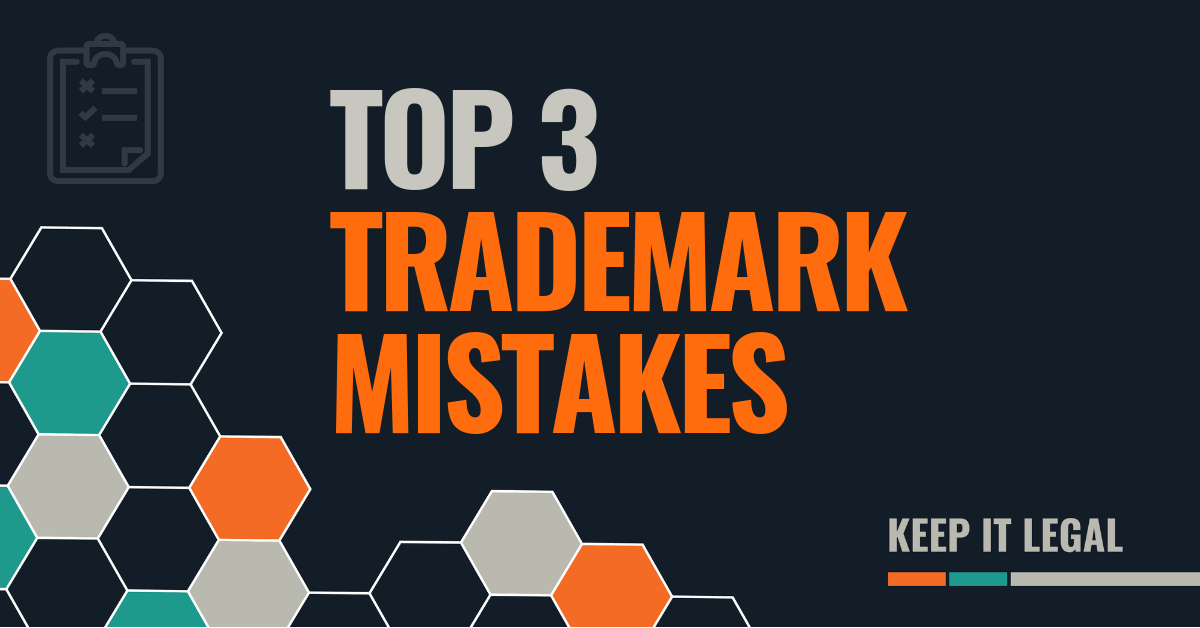One of the best things business owners can do to protect their intellectual property is to avoid common trademark mistakes. Trademarks are one area of the law where it’s easy to get tripped up. While many startups don’t seek legal advice when they begin building their trademark portfolio (for obvious reasons), it’s also easy to make serious trademark mistakes that could get you into trouble down the line. Here are the three most common trademark mistakes that I’ve seen in my practice.
Trademark Mistake #1: Not understanding where trademarks fit into your I.P. portfolio
Intellectual property can be separated into four main categories: patents, copyrights, trade secrets, and trademarks. Each category is equally important to a startup organization. From the very outset, companies should be thinking about whether to seek protection for the following intellectual assets:
- Patents: Patents provide protection for unique inventions. For example, an inventor could seek a design patent on a new engine design.
- Copyrights: Copyrights protect original works of authorship, regardless of whether they’re published or unpublished. A songwriter, for example, owns the copyright to the songs she writes.
- Trade Secrets: Trade secrets consist of information that is: (1) valuable because it is not known to the public generally; and (2) subject to reasonable efforts to maintain secrecy. A company’s list of sales contacts can be considered a trade secret if the company makes an effort to keep the list secret.
- Trademarks: Trademarks identify and distinguish the source of goods or services. They can include words, logos, symbols, or a combination. Many product names and logos are protected as trademarks.
Understanding these distinctions is critical. If you spend time and energy seeking a patent on your logo, for example, you’ll be sorely disappointed when your application is rejected by the U.S. Patent & Trademark Office (the “USPTO”) since patent law doesn’t apply to logos.
Trademark Mistake #2: Not understanding “first use in commerce”
United States law protects the person who first uses a trademark in commerce – regardless whether that person ever registered the mark with the USPTO. Let’s say, for example, that a salon owner in Jefferson County, Texas opened a business called “Nail Party.” Let’s also assume that she advertised her business throughout the county using flyers and brochures.
Even without seeking trademark protection from the USPTO, the salon owner is said to have a “common law trademark.” A common law mark protects her rights as the first person to use NAIL PARTY in commerce. Note, however, that common law trademarks are geographically limited. In this instance, the trademark would likely only be protected within Jefferson County.
This is why it’s so important to do nationwide name searches before settling on a business name and applying for a trademark. If other people or companies have used that name in commerce previously, your trademark rights could be severely limited and, by using that business name, you could be subject to a trademark infringement lawsuit.
Trademark Mistake #3: Using the wrong symbol
Using the wrong symbol is one of the most frequent trademark mistakes I see. Let me explain: there are two principal types of trademarks, common law trademarks (mentioned above) and registered trademarks. A registered trademark offers the greatest legal protection. It means the owner has applied for a formal trademark with the USPTO and the agency has registered the mark. Registered marks are designated with a ® symbol. Legally, use of this symbol in connection with an unregistered mark constitutes fraud.
The other trademark designation is the ™ symbol. It can be affixed to a logo or name without formal application or registration with the USPTO. This means that you are free to use ™ on any brand names or logos even if you haven’t applied for a trademark registration, as long as you believe in good faith that you aren’t infringing on anyone else’s trademark rights.
Getting Trademarks Right
Trademark mistakes are easy to make and the consequences can be vast. If you have questions about how to best protect your trademarks, please feel free to contact me. I can provide more information about your trademark issues or handle a full trademark registration.


